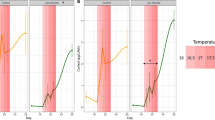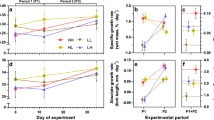Abstract
Hierarchies readily appear when rearing flounders through metamorphosis in space-limited conditions. In this experiment, subordinate fish were stressed, as suggested by their elevated cortisol level compared to dominant fish. Subordinate fish, although of smaller size than the dominant fish, showed no suppressed digestive capacity. By separating the two hierarchical groups into different tanks at low density, the cortisol level of the subordinate fish substantially decreased. The removal of the stressor also resulted in an increase in digestive function and improved coloration. Also, compensatory growth in length but not in weight was observed in the subordinate group, suggesting that the subordinate fish devoted their energy to increase their length. These results imply that the climax of flounder metamorphosis (i.e. the settlement stage) is a highly sensitive period, where social interactions may induce high levels of stress. However, Japanese flounder early juveniles prove to have a high recovery capacity from stress and show to allocate energy preferentially to growth in length. This seems to be an adaptation to diminish the probability of death by predation.
Similar content being viewed by others
References
Alvarez MC (1998) Factors affecting digestive function of Japanese flounder, Paralichthys olivaceus, larvae and early juvenile. MS Thesis, Graduate School of Agriculture, Kyoto University, Japan
Bailey KM, Houde ED (1989) Predation on egg and larvae of marine fishes and the recruitment problem. Adv Mar Biol 25:1–67
Blaxter JHS (1988) Physiology of developing fish. In: Hoar WS, Randall DJ (eds) Fish physiology, vol 11A. Academic Press, London, pp 1–58
Bonga SEW (1997) The stress response in fish. Physiol Rev 77:591–625
Cushing HD (1974) The possible density-dependence of larval mortality and adult mortality in fishes. In: Blaxter JHS (ed) The early life history of fish. Springer-Verlag, Berlin, pp 103–111
Dou S, Seikai T, Tsukamoto K (2000) Cannibalism in Japanese flounder juveniles, Paralichthys olivaceus, reared under controlled conditions. Aquaculture 182:149–159
Fairchild EA, Howell WH (2001) Optimal stocking density for juvenile winter flounder Pseudopleuronectes americanus. J World Aquacult Soc 32:300–308
Fukuhara O (1986) Morphological and functional development of Japanese flounder in early life stage. Bull Jpn Soc Sci Fisher 52:81–91
Gildberg A (2004) Digestive enzyme activities in starved pre-slaughter fanned and wild-captured, Atlantic cod (Gadus morhua). Aquaculture 238:343–353
Gilmour KM, DiBatista JD, Thomas JB (2005) Physiological causes and consequences of social status in salmonid fish. Integr Compar Biol 45:263–273
Hiroi J, Sakakura Y, Tagawa M, Seikai T, Tanaka M (1997) Developmental changes in low-salinity tolerance and responses of prolactin, cortisol and thyroid hormones to low-salinity environment in larvae and juveniles of Japanese flounder, Paralichthys olivaceus. Zool Sci 14:987–992
Magnuson JJ (1962) An analysis of aggressive behavior, growth, and competition for food and space in medaka (Oryzias latipes (Pisces, Cyprinodontidae)). Can J Zool 40:313–363
Mercier L, Audet C, de la Noue J, Parent B, Parrish CC, Ross NW (2004) First feeding of winter flounder (Pseudopleuronectes americanus) larvae: use of Brachionus plicatilis acclimated at low temperature as live prey. Aquaculture 229:361–376
Minami T, Tanaka M (1992) Life history cycles in flatfishes from the Notherwestern Pacific, with particular reference to their early life histories. Netherlands J Sea Res 29:35–48
Minami T (1982) The early life history of flounder, Paralichthys olivaceus. Bull Jpn Soc Sci Fisher 48:1581–1588 (In Japanese)
Mommsen TP, Vijayan MM, Moon TW (1999) Cortisol in teleosts: dynamics, mechanisms of action, and metabolic regulation. Rev Fish Biol Fisher 9:211–268
Sakakura Y, Tsukamoto K (2002) Onset and development of aggressive behavior in the early life stage of Japanese flounder. Fisher Sci 68:854–861
Seikai T, Kinoshita I, Tanaka M (1993) Predation by Crangonid shrimp on juvenile Japanese flounder under laboratory conditions. Nippon Suisan Gakkaishi 59:321–326
Seikai T, Tanangonan JB, Tanaka M (1986) Temperature influence on larval growth and metamorphosis of the Japanese flounder Paralichthys olivacetus in the laboratory. Bull Jpn Soc Sci Fisher 52:977–982
Smith ME, Fuiman LA (2003) Causes of growth depensation in red drum, Sciaenops ocellatus, larvae. Environ Biol Fish 66:49–60
Tanaka M, Goto T, Tomiyama M, Sudo H (1989) Immigration, settlement and mortality of flounder (Paralichthys olivaceus) larvae and juveniles in a nursery ground, Shijiki Bay, Japan. Netherlands J Sea Res 24:57–67
Tanaka M, Kawai S, Seikai T, Burke JS (1996) Development of the digestive organ systems in Japanese flounder in relation to metamorphosis and settlement. Mar Freshwater Behav Physiol 28:19–31
Ueberschär B, Clemmesen C (1992) A comparison of the nutritional condition of herring larvae as determined by 2 biochemical methods—tryptic enzyme-activity and RNA DNA ratio measurements. ICES J Mar Sci 49:245–249
Youson JH (1988) First metamorphosis. In: Hoar WS, Randall DJ (eds) Fish physiology, vol 6. Academic Press, London, pp 135–196
Acknowledgements
I would like to express my gratitude to Tadahisa Seikai, Shinȁ9ichiro Kawai, Masamoto Tagawa, Tatsuya Kaji and Yasuko Kaji for their kind assistance and guidance. This study was supported by a scholarship from the Japanese Ministry of Education to MCA.
Author information
Authors and Affiliations
Corresponding author
Rights and permissions
About this article
Cite this article
Alvarez, M., Pérez-Domínguez, R. & Tanaka, M. Digestive capacity, growth and social stress in newly-metamorphosed Japanese flounder (Paralichthys olivaceus). Environ Biol Fish 77, 133–140 (2006). https://doi.org/10.1007/s10641-006-9065-9
Received:
Accepted:
Published:
Issue Date:
DOI: https://doi.org/10.1007/s10641-006-9065-9




